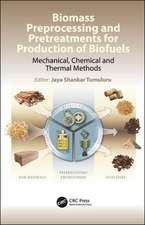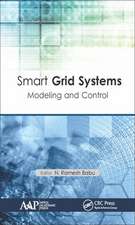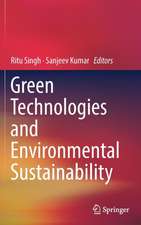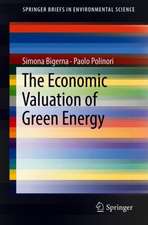The Sustainability of Renewable Energy in Europe
Autor Simona Bigerna, Carlo Andrea Bollino, Silvia Michelien Limba Engleză Hardback – 30 mar 2015
| Toate formatele și edițiile | Preț | Express |
|---|---|---|
| Paperback (1) | 633.19 lei 43-57 zile | |
| Springer International Publishing – 6 oct 2016 | 633.19 lei 43-57 zile | |
| Hardback (1) | 639.25 lei 43-57 zile | |
| Springer International Publishing – 30 mar 2015 | 639.25 lei 43-57 zile |
Preț: 639.25 lei
Preț vechi: 752.06 lei
-15% Nou
Puncte Express: 959
Preț estimativ în valută:
122.36€ • 132.95$ • 102.85£
122.36€ • 132.95$ • 102.85£
Carte tipărită la comandă
Livrare economică 21 aprilie-05 mai
Preluare comenzi: 021 569.72.76
Specificații
ISBN-13: 9783319123424
ISBN-10: 3319123424
Pagini: 137
Ilustrații: VIII, 137 p. 6 illus. in color.
Dimensiuni: 155 x 235 x 15 mm
Greutate: 0.39 kg
Ediția:2015
Editura: Springer International Publishing
Colecția Springer
Locul publicării:Cham, Switzerland
ISBN-10: 3319123424
Pagini: 137
Ilustrații: VIII, 137 p. 6 illus. in color.
Dimensiuni: 155 x 235 x 15 mm
Greutate: 0.39 kg
Ediția:2015
Editura: Springer International Publishing
Colecția Springer
Locul publicării:Cham, Switzerland
Public țintă
ResearchCuprins
The EU legal frameworks.- RES Scenario in the Europ.- RES Scenario in the European Union.- Strategic choices for sustainability at EU regional level.- EU scenarios for a sustainable RES strategy.
Notă biografică
Drs. Simona Bigerna, Carlo Andrea Bollino and Silvia Micheli are Professors of Economics at the University of Perugia in Italy whose current research interests highlight the policy, micro- and macro-economic issues impacting the implementation of sustainable and renewable energy technologies.
Textul de pe ultima copertă
· Provides an overview of environmentally-driven energy policies at global, European and regional levels
· Explains a new model for lowering management costs of achieving key environmental targets, with detailed comparative regional cost analyses
· Considers the implications of broad energy policies on soil, water and biodiversity
This book demonstrates that the much-needed global shift in energy production and use must happen at a territorial level in order to be truly successful and sustainable. This book enables regional implementation efforts by connecting broad EU environmental policies with plans for action at the territorial level, analyzing efficient resource allocation and cost effectiveness to achieve national objectives. Each EU Member State is considered in depth, in order to identify the opportunities and challenges of this regional approach. The regional dimension of the authors’ analysis refers to the territorial level NUTS 1 (Nomenclature of Territorial Units for Statistics) that, starting from the administrative borders of the EU countries, divides the territory into 97 regions on the basis of major socio-economic characteristics. Because the model of the EU "green economy" is characterized typically by top-down interventions that focus exclusively on the resource productivity and investment business, its practical implementation can be de-railed. This book provides the pivotal missing piece- the detailed territorial comparative analysis necessary to obtain an optimal energy mix of renewable energy sources (RES), energy conservation and energy efficiency characteristics of each specific local context.
· Explains a new model for lowering management costs of achieving key environmental targets, with detailed comparative regional cost analyses
· Considers the implications of broad energy policies on soil, water and biodiversity
This book demonstrates that the much-needed global shift in energy production and use must happen at a territorial level in order to be truly successful and sustainable. This book enables regional implementation efforts by connecting broad EU environmental policies with plans for action at the territorial level, analyzing efficient resource allocation and cost effectiveness to achieve national objectives. Each EU Member State is considered in depth, in order to identify the opportunities and challenges of this regional approach. The regional dimension of the authors’ analysis refers to the territorial level NUTS 1 (Nomenclature of Territorial Units for Statistics) that, starting from the administrative borders of the EU countries, divides the territory into 97 regions on the basis of major socio-economic characteristics. Because the model of the EU "green economy" is characterized typically by top-down interventions that focus exclusively on the resource productivity and investment business, its practical implementation can be de-railed. This book provides the pivotal missing piece- the detailed territorial comparative analysis necessary to obtain an optimal energy mix of renewable energy sources (RES), energy conservation and energy efficiency characteristics of each specific local context.
Caracteristici
Provides an overview of environmentally-driven energy policies at global, European and regional levels Explains a new model for lowering management costs of achieving key environmental targets, with detailed comparative regional cost analyses Considers the implications of broad energy policies on soil, water and biodiversity Includes supplementary material: sn.pub/extras

























